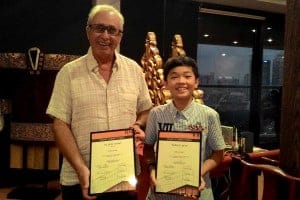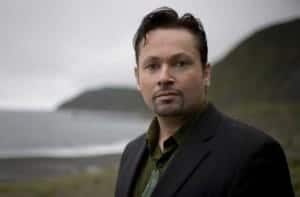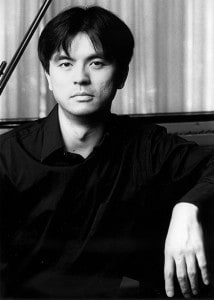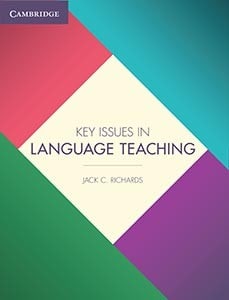Season’s greetings from children whose English lessons Dr. Richards sponsors at a language institute in Antigua, Guatemala.
Curator for decorative arts collection

Jack’s new book published
Key Issues in Language Teaching – a major overview and discussion of the field of English language teaching, was published in September 2015, by Cambridge University Press. Jack has been working on this project for over 5 years. The final book is 826 pages and is available both as a print book and an e-book.
Joshua Han wins two prizes in Aarhus

Josh and his family were guests at Jack’s New Zealand summer house in January 2015, and Josh and his brother Oscar – a very talented violinist – performed at a charity concert in Gisborne.
Second performance of Farr piano concerto

Pianist Tony Lee returned to perform the concerto with the BBC Symphony Orchestra in London.
Materials for a Text-based approach
Question:
Submitted by Trueter, South Africa
What materials does a teacher make use of when using a text-based approach?
Professor Richards Responds:
Teaching is based around spoken and written texts relevant to the learners’ needs and interests. Such texts are used to model the kinds of texts the learners need to master. For more information see my article “Communicative language teaching today”.
Teaching absolute beginners
Question:
Submitted by N. Kazemi, Iran
How should we start teaching English to absolute beginners who neither know even a single word in English nor have any literacy skills even in terms of recognizing the English alphabet?
Professor Richards Responds:
It will be necessary to start with vocabulary recognition, phonics, and then to build up a core recognition and productive vocabulary, using pictures and translation. Production should be very limited initially until these core requirements have been met.
Teaching Materials
Question:
Submitted by Monsume, Azerbaijan
Are visual aids and technological resources included as teaching materials?
Professor Richards Responds:
Yes indeed. Teaching materials refers to any of the resources that the teacher makes use of to support his or her teaching. This includes a wide variety of print and technology-based resources.
Objective of Teaching English to 7-10 year olds
Question:
Submitted by Adriana Patrus, Brazil
I teach English to primary schoolchildren in Brazil. The classes are monolingual and they range from 22 to 30 students. They speak Portuguese the whole time except for a few minutes of repetition, drilling, singing and an occasional speaking activity. They have been able to master quite a range of vocabulary but no attempt to speak it yet. Should we feel frustrated that they don’t try to speak the odd words they learn in the monolingual classroom? What should be ultimately the primary objective of teaching English to 7-10 year olds?
Professor Richards Responds:
Yes I think frustration would be an approriate response. I suggest use more activities that require production of simple phrases and words that they have learned, such as games and simple dialogs. The following are examples of goals for courses for young learners:
- To develop a set of core vocabulary and expressions for use in simple conversation
- To build confidence
- To provide the motivation to learn English
- To encourage ownership of language
- To encourage children to communicate with whatever language they have at their disposal (mime, gesture, key word, drawings, etc.)
- To encourage children to treat English as a communication tool, not as an end product
- To show children that English is fun
- To establish a trusting relationship with children and encourage them to do the same with their classmates
- To give children an experience of a wide range of English language in a non-threatening environment
Bottom-up, Top-down or Interactive Processing
Question:
Submitted by Hannah, Korea
I wonder if the activity below makes use of to bottom-up processing, top-down processing or Interactive processing.
Task: Read a sentence and then listen to a sentence on tape to decide if the meaning is the same or different.
Professor Richards Responds:
In order to complete this task the listener has to hold the spoken sentence in short term memory, decode its meaning, and then compare the result with his or her understanding of the written text. The extent of bottom-up or top-down processing involved will depend on the contents of the sentence, since it may or may not draw on background knowledge or culturally specific schemata. No interactive processing is involved if we use this term to refer to interaction with a speaker.
New Key Issues in Language Teaching book
Question:
Submitted by Muhammad Shujaat, Saudi Arabia
When will your new book Key Issues in Language Teaching be launched?
Professor Richards Responds:
Publication of the book has been delayed due to difficulties in clearing permissions for many of the citations that occur through the text, of which there are several hundred. Some greedy publishers have been asking up to $1000 to cite a 45 word extract from a journal article, and some have not yet responded to requests to cite from sources they hold the copyright for. In many instances I have hence had to rewrite and rephrase citations due to copyright restrictions. My publisher has informed me that she has set March 22 as the deadline to clear copyright issues, and anything not clarified by that date I will have to rewrite. She is now suggesting a June 2015 publication date for the e-book and a July date for the print book. WATCH THIS SPACE!
Course book versus Textbook
Question:
Submitted by Elaine Borges, Brazil
Is there is a difference between the definition of “course book” and “textbook” for teaching second/foreign languages?
Professor Richards Responds:
No these two terms are used interchangeably.
Teaching Young Learners
Question:
Submitted by Niloofar, Iran
What would you recommend for someone wanting to learn more about teaching young learners?
Professor Richards Responds:
There is a module on young learners as part of the TKT test, which you can access on-line.
Methods & Curriculum Development
Question:
Submitted by Shirmohammad Barani, Iran
In what ways do methods raise issues related to curriculum development?
Professor Richards Responds:
Choosing and evaluating teaching methods is part of the process of curriculum development. For further information see the article on my website called “Curriculum strategies in language teaching”.
Indonesia October 2015
This slideshow requires JavaScript.
Traditional versus Digital Media in Teaching
Question:
Submitted by Rizky Amelia Banjarmasin, Indonesia
In this global era, the use of media involving technology in teaching English is increasing. As a result, traditional media seems to be ignored. Therefore, I would like to ask what are the benefits of traditional media in contrast to digital media and how to maximize traditional media?
Professor Richards Responds:
Technology is certainly having a considerable impact on language teaching today but does not necessarily replace the use of more traditional media. What today’s technology does do is provide opportunities for learners to extend their contact and use of English beyond the classroom, and hence enables learners to make use of out-of-class autonomous learning based on their interests and needs. For examples and more detailed discussion see my the recent article on my website entitled “The changing face of language learning”.
Tairawhiti Museum Free Concerts

There will be six concerts scheduled throughout the year. These will be free events for Gisborne residents and are intended both to showcase the talents of NZSM students as well as to help expand the community outreach of the museum.
Gao Ping Trio Commission

Sources for Teaching Adult Learners
Question:
Submitted by Farid Bozorgmehr, Iran
What sources can you recommend for teaching English to adult learners?
Professor Richards Responds:
- Marshall, B. (2002) Preparing for Success: A guide for Teaching Adult English Language Learners, McHenry, IL: Delta Systems, Inc. and Washington, DC: Center for Applied Linguistics.
- Murray, D. E. (2005) ‘ESL in adult education’, In E. Hinkel (ed.), Handbook of Research in Second Language Teaching and Learning, Mahwah, NJ: Lawrence Erlbaum Associates, pp. 65–84.
- Orem, R. A. (2012) ‘Teaching adults’, In A. Burns and J. C Richards (eds.), The Cambridge Guide to Pedagogy and Practice in Language Teaching, New York: Cambridge University Press.
Direct & Indirect Approaches to Teaching Speaking
Question:
Submitted by Yanina Valdez, Argentina
What is the difference between direct and indirect approaches to speaking?
Professor Richards Responds:
An indirect approach to the teaching of speaking is one in which oral competence is acquired incidentally as a bi-product of engaging in communicative tasks. No specific aspects of speaking may be targeted. A direct approach is one in which specific aspects of speaking (e.g. turn taking, back-channeling) are targeted through focused instruction directed at these features.
